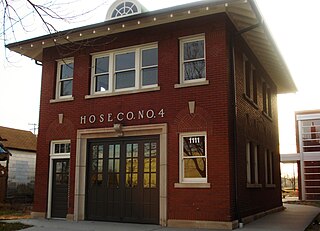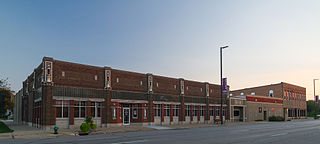
Cedar Rapids is the second-largest city in Iowa, United States and is the county seat of Linn County. The city lies on both banks of the Cedar River, 20 miles (32 km) north of Iowa City and 100 miles (160 km) northeast of Des Moines, the state's capital and largest city. It is a part of the Cedar Rapids/Iowa City region of Eastern Iowa, which includes Linn, Benton, Cedar, Iowa, Jones, Johnson, and Washington counties.

Brucemore, a park-like, 26-acre (110,000 m2) estate in the heart of Cedar Rapids, Iowa, is the site of a Queen Anne-style mansion, formal gardens, a children's garden, night garden, pond, orchard, and woodland. Built between 1884 and 1886 by Caroline Sinclair, widow of pioneer industrialist T.M. Sinclair, Brucemore has been home to three prominent families who used the estate as a center for culture and the arts. Brucemore, whose name alludes to the Scottish moors of the second owner's ancestral home, is Iowa's only National Trust Historic Site and is preserved by the National Trust for Historic Preservation in co-stewardship with Brucemore, Inc. Under the name of the T.M. Sinclair Mansion, it is listed on the National Register of Historic Places. The mansion has three stories, and contains twenty-one rooms. Distinctive features include a steeply gabled roof, five chimneys, and several turrets.

The Mother Mosque of America, once known as The Rose of Fraternity Lodge, in Cedar Rapids, Iowa, United States, is the oldest standing purpose-built mosque in the United States, having been completed in 1934. The Al-Sadiq Mosque in Chicago and the Powers Street Mosque are older by a decade but were converted from existing buildings to be used as a Muslim house of worship.

May's Island is a small island on the Cedar River, in Cedar Rapids, Iowa. Functioning as a civic center much like the Île de la Cité, it is the site of the Memorial Building, the Linn County Courthouse, and the county jail. The island plus an adjacent block was listed as a historic district on the National Register of Historic Places in 1978.

The First Universalist Church of Cedar Rapids, also called the Peoples Church Unitarian Universalist is listed on the National Register of Historic Places. Built in 1875, it served the Unitarian Universalist community of Cedar Rapids, Iowa, USA, for more than 135 years. Because of the high cost of upkeep and diminishing membership, the congregation voted to sell the building and grounds in May 2010. It was demolished in October 2011.

The Burlington, Cedar Rapids and Northern Railway (BCR&N) was a railroad that operated in the United States from 1876 to 1903. It was formed to take over the operations of the bankrupt Burlington, Cedar Rapids and Minnesota Railway, which was, in turn, the result of merging several predecessor lines, the construction of which began in 1869. The corporate headquarters were in Cedar Rapids, Iowa, and it had operations in Iowa and in Minnesota. It was succeeded by the Chicago, Rock Island and Pacific Railway.

The Linn County Courthouse is located on May's Island in the middle of the Cedar River in Cedar Rapids, Iowa, United States. It, along with the Veterans Memorial Building and two other buildings, is a contributing property to the May's Island Historic District that was listed on the National Register of Historic Places in 1978. The courthouse is the third building the county has used for court functions and county administration.

The Bohemian Commercial Historic District, also known as New Bohemia, is located in Cedar Rapids, Iowa, United States. It was listed on the National Register of Historic Places in 2002. At the time of its nomination it consisted of 75 resources, which included 48 contributing buildings, and 27 non-contributing buildings. Bohemian immigrants began settling in Cedar Rapids in the 1850s, and increasingly after the American Civil War in the 1860s and the Austro-Prussian War in 1866. They grew to be the largest ethnic group in the city, and the only one to settle in a distinct part of Cedar Rapids. They settled along the Cedar River between the downtown area and the T.M. Sinclair and Company meat packing plant. The buildings in the district were constructed between the 1880s and the 1930s. They are largely narrow-front commercial buildings and corner blocks. The buildings housed a variety of commercial establishments: a movie theater, two banks, and several filling stations. It also includes a railroad corridor factory building, a fire station, and fraternal halls. The buildings are representative of various commercial architectural styles and vernacular building forms popular at the times they were built. The Lesinger Block (1883) and the C.S.P.S. Hall (1891) are individually listed on the National Register of Historic Places.

The Cedar Rapids Post Office and Public Building, also known as the Witwer Building, is an historic building located in downtown Cedar Rapids, Iowa, United States. It was individually listed on the National Register of Historic Places in 1982. In 2015 it was included as a contributing property in the Cedar Rapids Central Business District Commercial Historic District.

The David and M. Maria Hughes House is a historic building located in Williamsburg, Iowa, United States. David Hughes, a Williamsburg native, was serving as Iowa County Superintendent of Schools and deputy clerk of court when he established the Iowa Lumber Company. The company was renamed Hughes and Brother Lumber when his brother John joined the business. The brothers became wealthy as the result of a building boom in town after the arrival of the Chicago, Milwaukee, and St. Paul Railroad in 1884. David's wife M. Maria (Morse) Hughes was a school teacher. Because of poor eyesight, Hughes retired the year the house was completed, and he sold his share of the business to his brother. He and his wife relocated to their other home in Long Beach, California in 1906, where they owned a considerable amount of real estate. The house remained a single-family dwelling until 1951 when it was divided into three apartments. Starting in the 1980s three separate owners have worked to return the house to its original floor plan.

Clermont Public School, also known as Larrabee School, is a historic building located in Clermont, Iowa, United States. The school was named for its patron, William Larrabee, who was the twelfth Governor of Iowa. Larrabee himself had been a teacher in Allamakee County, Iowa. During his time in the Iowa Senate and as governor he championed education reform. He used as one of his campaign slogans: "A schoolhouse on every hill and no saloons in the valley." Larrabee and his wife Anna studied school buildings for a number of years, and were involved in planning this building. They hired Cedar Rapids, Iowa architect Charles A. Dieman to design the structure. R.A. Wallace, a contractor from Cedar Rapids, was responsible for its construction. The building was over-engineered as Larrabee insisted that the strength of everything be doubled. The bricks were produced, and the limestone was quarried, locally. It is a two-story Neoclassical building that features a classical portico, brick pilasters with Doric capitals, and two arched dormers on the hipped roof.

The Mills Tower Historic District is a nationally recognized historic district located in Iowa Falls, Iowa, United States. It was listed on the National Register of Historic Places in 1990. At the time of its nomination the district consisted of six resources, including two contributing buildings, and four non-contributing buildings. All of the buildings are associated with the Illinois Central Railroad (IC). The Dubuque & Sioux City Railroad, an affiliate of the IC, laid the first rail track to Iowa Falls in 1866. The following year the Iowa Falls & Sioux City Railroad, another IC affiliate, continued construction of the line to the west, and it reached Sioux City by 1870. The Burlington, Cedar Rapids and Northern Railway (BCR&N) by way of its affiliate the Cedar Rapids, Iowa Falls & North Western, entered Iowa Falls in 1880. Two years later it was expanded to the north and intersected with the IC main line, which required a controlled crossing. Little is known about this first crossing and what it contained.

The Philip A. Wolff House and Carriage House, also known as Belmont Hill, is a historic building located in Cedar Rapids, Iowa, United States. An Ohio native, Wolff lived in several states and the West Indies before settling in Maquoketa, Iowa. He moved to Cedar Rapids where he established a brickworks with his son. Wolff had this two-story vernacular Italianate house and accompanying carriage house built in 1883 with bricks made at his business, which was on the same grounds. At the time it was built, the house was located in a suburban area of Cedar Rapids. This was during a period of economic growth for the city. The house features paired brackets under the eaves, the windows have brick arches above and limestone sills, a three-sided, two-story bay, and a projecting center pavilion. The carriage house is architecturally similar to the main house. They were listed together on the National Register of Historic Places in 1982.

The Lesinger Block, also known as Little Bohemia, is a historic building located in Cedar Rapids, Iowa, United States. This building was constructed at a time of economic expansion in the city. It is a contemporary of several Italianate commercial blocks that were built downtown. Because of subsequent development in that commercial district those buildings have been replaced with newer structures leaving this building as the best extant example of commercial Italianate in Cedar Rapids. It was constructed by Vaclav Lesinger, an immigrant from Kozlov, Bohemia. He was a tailor by trade and he had this structure built in 1883 to house his tailor shop and a dry goods store. Since 1907 the building has housed a tavern that has served as a social center for the local Bohemian community. Architecturally, the two-story brick structure still retains a good deal of its original wood ornamentation, including the sawtooth frieze above the storefronts and the geometric design in the bracketed cornice.
The Second and Third Avenue Historic District is located in Cedar Rapids, Iowa, United States. It was listed on the National Register of Historic Places in 2000. At the time of its nomination it consisted of 186 resources, which included 176 contributing buildings, and 10 non-contributing buildings. This area was developed as a streetcar suburb at the turn of the 20th century. It includes single-family dwellings, apartment buildings, and two churches. The upper part of the district is called the Sampson Heights Addition. It was developed by Ellen Bever Blake and realtor/developer Malcolm Bolton. Blake's brothers James and George Bever developed the lower part of the district that they called the Bever Park Addition. The family members were in litigation for four years over the development as the two Bever sisters maintained that the three brothers received a disproportionate share of the property in their father's estate, and that they never paid for their stock in the Bever Land Company. In the end, their father's will was set aside and the five children agreed to divide the estate equally.

The B Avenue NE Historic District is a nationally recognized historic district located in Cedar Rapids, Iowa, United States. It was listed on the National Register of Historic Places in 2013. At the time of its nomination it consisted of 210 resources, which included 167 contributing buildings, and 43 non-contributing buildings. This is a working and middle-class neighborhood northeast of the campus of Coe College. It includes single-family dwellings, a church, and a school. The buildings are representative of various architectural styles and vernacular building forms popular from c. 1875 to 1963. The oldest house was built in 1873 and moved here in the early 20th century. Bungalow, Craftsman, and American Foursquare houses are dominant. A simple side-tower church, originally Central Park Presbyterian Church, was built in 1904. For the most part, architect-designed buildings are a rarity here. The houses are designs from pattern books. Cedar Rapids architect William J. Brown designed Benjamin Franklin Junior High School (1923).

The Cedar Rapids Central Business District Commercial Historic District is a nationally recognized historic district located in Cedar Rapids, Iowa, United States. It was listed on the National Register of Historic Places in 2015. At the time of its nomination it consisted of 60 resources, which included 46 contributing buildings, one contributing structure, 12 non-contributing buildings, and one non-contributing structure. Cedar Rapids was platted on the east bank of the Cedar River as Rapids City in 1841, and it was incorporated under the same name in 1849. Kingston was established on the west bank of the river in 1852. The two smaller communities consolidated in 1870 as Cedar Rapids. The streets were laid out parallel and perpendicular to the river, which flowed from the northwest to the southeast. The Chicago, Iowa and Nebraska Railroad was the first to arrive in the community in 1859 and the tracks were laid on Fourth Street on the eastern edge of the central business district. The first bridge across the river was built at Third Avenue in 1871.

The West Side Third Avenue SW Commercial Historic District is a nationally recognized historic district located in Cedar Rapids, Iowa, United States. It was listed on the National Register of Historic Places in 2014. At the time of its nomination it consisted of 10 resources, which included seven contributing buildings and three non-contributing buildings. Cedar Rapids was platted on the east bank of the Cedar River as Rapids City in 1841, and it was incorporated in 1849. Kingston was established on the west bank of the river in 1852, and it was annexed by Cedar Rapids in 1870. The streets were laid out parallel and perpendicular to the river, which flowed from the northwest to the southeast. The Chicago, Iowa & Nebraska Railway, later the Chicago & North Western Railway, was the prominent railroad on the west side of town. The first bridge across the river at Third Avenue was built in 1871. The current bridge was completed in 1912. Prior to a bridge, Rapid City and Kingston were connected by a ferry operated by David W. King, the founder of Kingston.

Our Mother of Sorrows Grotto Historic District is a nationally recognized historic district located on the Mount Mercy University campus in Cedar Rapids, Iowa, United States. It was listed on the National Register of Historic Places in 2015. It consists of a lagoon and five structures dedicated to the Virgin Mary. They include two arched entryways, a bridge, a ten-column structure representing the Ten Commandments, and a canopy enclosing a marble statue of the Virgin Mary. It was built by William H. Lightner, a self-trained architect, between 1929 and 1941. He utilized 12 tons of stone and 300 varieties of Italian mosaic glass that he acquired in his travels of more than 40,000 miles (64,000 km).
The Dr. Percy and Lileah Harris House is a historic building located in Cedar Rapids, Iowa, United States. It was listed on the National Register of Historic Places in 2021.






















